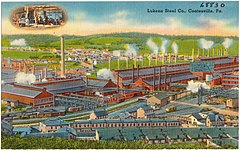
Coatesville is a city in Chester County, Pennsylvania, United States. The population was 13,350 at the 2020 census. Coatesville is approximately 39 miles west of Philadelphia. It developed along the Philadelphia and Lancaster Turnpike beginning in the late 18th century. It spans U.S. Route 30, the "Main Line" highway that runs west of Philadelphia.

Red Summer was a period in mid-1919 during which white supremacist terrorism and racial riots occurred in more than three dozen cities across the United States, and in one rural county in Arkansas. The term "Red Summer" was coined by civil rights activist and author James Weldon Johnson, who had been employed as a field secretary by the National Association for the Advancement of Colored People (NAACP) since 1916. In 1919, he organized peaceful protests against the racial violence.

Jim McMillan was lynched in Bibb County, Alabama on June 18, 1919.

The Washington race riot of 1919 was civil unrest in Washington, D.C. from July 19, 1919, to July 24, 1919. Starting July 19, white men, many in the armed forces, responded to the rumored arrest of a black man for the rape of a white woman with four days of mob violence against black individuals and businesses. They rioted, randomly beat black people on the street, and pulled others off streetcars for attacks. When police refused to intervene, the black population fought back. The city closed saloons and theaters to discourage assemblies. Meanwhile, the four white-owned local papers, including the Washington Post, fanned the violence with incendiary headlines and calling in at least one instance for mobilization of a "clean-up" operation.

The Ellenton riot or Ellenton massacre occurred in September 1876 and took place in South Carolina in the United States. The massacre was preceded by a series of civil disturbances earlier that year following tensions between the Democratic Party and the Republicans. Author Mark M. Smith concluded that there was one white and up to 100 blacks killed, with several white people wounded. While John S. Reynolds and Alfred B. Williams cite much lower numbers.

The Johnson–Jeffries riots refer to the dozens of race riots that occurred throughout the United States after African-American boxer Jack Johnson defeated white boxer James J. Jeffries in a boxing match termed the "Fight of the Century". Johnson became the first black World Heavyweight champion in 1908 which made him unpopular with the predominantly white American boxing audiences. Jeffries, a former heavyweight champion came out of retirement to fight Johnson and was nicknamed the "Great White Hope". After Johnson defeated Jeffries on July 4, 1910, many white people felt humiliated and began attacking black people who were celebrating Johnson's victory.

The New London riots of 1919 were a series of racial riots between white and black Navy sailors and Marines stationed in New London and Groton, Connecticut.

The Dublin, Georgia riot of 1919 were a series of violent racial riots between white and black residents of Dublin, Georgia.

The Syracuse riot of 1919 was a violent racial attack that occurred when the management of the Globe Malleable Iron Works pitted striking white unionized workers against black strikebreakers in Syracuse, New York on July 31, 1919.

The Newberry 1919 lynching attempt was the attempted lynching of Elisha Harper, Newberry, South Carolina on July 24, 1919. Harper was sent to jail for insulting a 14-year-old girl.
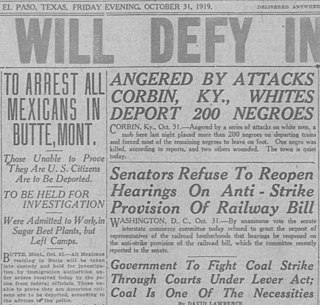
Corbin, Kentucky race riot of 1919 was a race riot in 1919 in which a white mob forced nearly all the town's 200 black residents onto a freight train out of town, and a sundown town policy until the late 20th century.
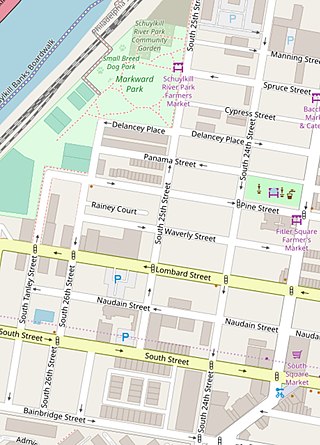
There were a number of race riots in Philadelphia during the 1919 Red Summer.

The Wilmington, Delaware race riot of 1919 was a violent racial riot between white and black residents of Wilmington, Delaware on November 13, 1919.
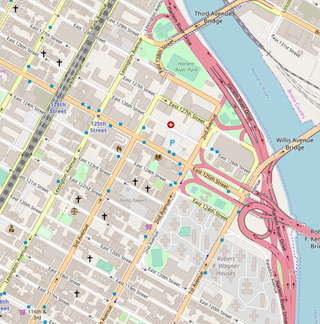
The New York race riots of 1919 developed with increasing racial tension and violent incidents in New York City. These riots were a part of the Red Summer, a series of violent terrorist attacks on black communities in many cities in the United States during the summer and early autumn of 1919. The New York race riots were caused by social tensions such as competition for jobs, politics, and racial tension. Many historians and scholars view these riots as the culmination of racial tensions which had been rising due to the migration of African Americans from the rural South to northern cities. Tensions developed partly due to the competition for jobs, which was worsened by the presence of African Americans workers who could replace striking White workers.

The Laurens County, Georgia race riot was an attack on the black community by white mobs in August 1919. In the Haynes' report, as summarized in the New York Times, it is called the Ocmulgee, Georgia race riot.

Miles Phifer and Robert Crosky were lynched in Montgomery, Alabama for allegedly assaulting a white woman.

Paul Jones was lynched on November 2, 1919, after being accused of attacking a fifty-year-old white woman in Macon, Georgia.

The lynching of Zachariah Walker occurred on August 13, 1911, in Coatesville, Pennsylvania. A white mob attacked and burned African American steelworker Zachariah Walker alive in retaliation for reportedly killing Edgar Rice, a white Worth Brothers Steel company police officer.
The 1917 Chester race riot was a race riot in Chester, Pennsylvania, that took place over four days in July 1917. Racial tensions increased greatly during the World War I industrial boom due to white hostility toward the large influx of southern blacks who moved North as part of the Great Migration. The riot began after a black man walking in a white neighborhood with his girlfriend and another couple bumped into each other. This led to a fight in which the black man stabbed and killed the white man. In retaliation, white gangs targeted and attacked blacks throughout the city. Four days of violent melees involving mobs of hundreds of people followed. The Chester police along with the Pennsylvania National Guard, Pennsylvania State Police, mounted police officers and a 150-person posse finally quelled the riot after four days. The riot resulted in 7 deaths, 28 gunshot wounds, 360 arrests and hundreds of hospitalizations.
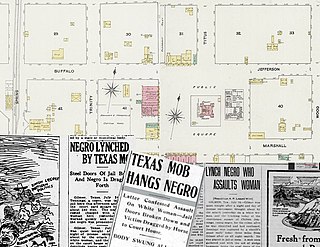
Chilton Jennings was lynched on July 24, 1919, after being accused of attacking a white woman, Mrs. Virgie Haggard in Gilmer, Texas.
